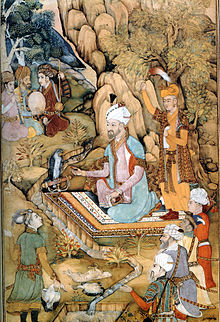Kaftan

A kaftan or caftan ( خفتان xaftân) is a front-buttoned coat or overdress, usually reaching to the ankles, with long sleeves. It can be made of wool, cashmere, silk, or cotton. It may be worn with a sash.
It is a variant of the robe or tunic, versions of which have been worn by countless cultures around the world, for thousands of years. The kaftan is associated with Islamic or Islamicate cultures. Kaftans were often worn as court robes; the splendor and specific decorations of the kaftan indicated the rank of the wearer. Sovereigns often gave ornate kaftans as a mark of favor.
Persian kaftans


Persian robes of honor were commonly known as khalat or kelat.[1]
Ottoman kaftans
The kaftans worn by the Ottoman sultans are preserved in one of the most splendid collections of Topkapı Palace in Istanbul. Lavishly decorated kaftans were given as rewards to important dignitaries and victorious generals. The decorations—colours, patterns, ribbons, and buttons—indicated the rank of the person to whom they were presented.
From the 14th century through 17th centuries, textiles with large patterns were used. The decorative patterns on the fabrics became both smaller and brighter in the late 16th and in the 17th centuries. By the second half of the 17th century, the most precious fabrics were those with 'yollu': vertical stripes with various embroideries and small patterns, the so-called "Selimiye" fabrics.
Most fabrics manufactured in Turkey were made in Istanbul and Bursa, but some textiles came from as far away as Venice, Genoa, Persia (Iran), India and even China. Kaftans were made from velvet, aba, bürümcük (a type of crepe with a silk warp and cotton weft), canfes, çatma (a heavy silk brocade), gezi, diba (Persian دیبا), hatayi, kutnu, kemha, seraser (Persian سراسر) (brocade fabric with silk warp and gold or silver metallic thread weft[2]), serenk, zerbaft (Persian زربافت), tafta (Persian تافته). Favoured colours were indigo blue, kermes red, violet, pişmis ayva or "cooked quince", and weld yellow.
The Topkapı Museum, Istanbul, possesses a large collection of Ottoman kaftans and textiles.[3]
Moroccan kaftans
In Morocco kaftans are only worn by women, see Takshita. These robes differ in many ways from their Turkish counterparts. They can be dressy casual to extremely formal, depending on the materials used.
West African kaftans
In West Africa, a kaftan is a pullover robe. Kaftans are worn by both men and women. In West Africa, the female robe is called a kaftan, and the male robe is called the boubou or Senegalese kaftan.
Russian kaftans
In Russia the word "kaftan" is used for another type of clothing: a kind of a man's long suit with tight sleeves. By the 19th century, Russian kaftans were the most widely spread type of outer clothing among peasants and merchants. Currently they are used as a ritual religious clothing by the most conservative sect of Old Believers.
Southeast Asian kaftans
In South East Asia, kaftans are often worn as cool, casual hot weather attire. Batik fabric is often used.
Western fashion
American hippie fashions of the late 1960s and the 1970s often drew from ethnic styles, including kaftans. African-styled, kaftan-like dashikis were popular, especially among African-Americans. Street styles were appropriated by fashion designers, who marketed lavish, Moroccan-style kaftans as hostess gowns for casual at-home entertaining.
See also
- Ottoman clothing
- Takchita
- Senegalese kaftan
- Boubou (clothing)
- Kaftan (boubou)
- Kanzu
- Dashiki
- Kufi
- Deel (clothing)
References
- ^ http://www.iranicaonline.org/articles/clothing-xxvii
- ^ http://www.sadberkhanimmuzesi.org.tr/default.asp?page=koleksiyon&kl=detay&tkid=9&oid=26&aid=65&id=75&hl=en Sadberk Hanim Museum
- ^ IstanbulNet @ www.istanbulnet.com.tr. "Topkapi Museum: collection of Turkish textiles and kaftans". Exploreturkey.com. Retrieved 2009-10-09.
